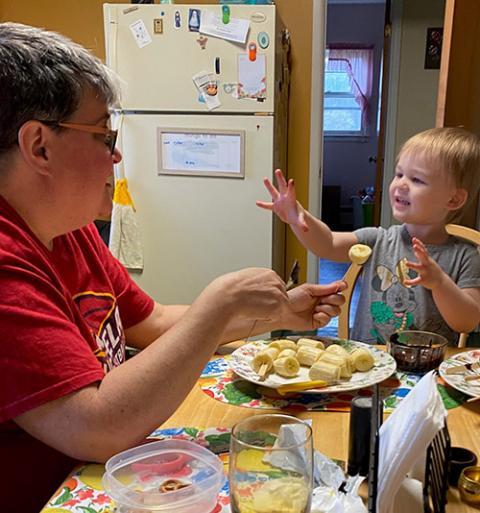
My students and I find a little moment of joy together. (Courtesy of Jennifer Wilson)
It is 8 a.m. and I am asking my students in homeroom to identify how they are feeling on a number scale of one to 10, with 10 being the best. As the days have gone on and we approached and passed the one-year mark of this pandemic, I noticed a change in myself and in my students.
It seemed that when we chose a number to identify how we were feeling overall each day, we had begun to say seven instead of nine or 10. A student — normally a 10 but who had dropped down to sevens for a while — said to me, "Well, besides the fact that I wish I was still in bed this early in the morning, there isn't a real reason I feel this way every day. I just feel meh."
Then another student asked her, "Are you depressed?" Several students began saying that they feel the same way, and that it does not feel exactly like depression. They talked about still having energy, about wanting to participate and be involved, and that they did not feel like they were tired all the time.
I was impressed that they were identifying their feelings. I am glad that they are aware of and can recognize the signs of depression. I talked with them and told them that I thought I understood what they were talking about and that I was experiencing it also. I told them maybe it was pandemic fatigue. They said that their parents have talked about feeling like this also.
People who have lost loved ones, or who have been very sick themselves, have suffered far more than the majority of my students and I have. I have been inconvenienced but I have not suffered. I have struggled to figure out how to teach students online at home and at school at the same time. Plans have been made and remade and then canceled, but at the end of the day I am fine.
Advertisement
However, this feeling that my students and I had difficulty describing and for which we could not exactly find a word is still there. A recent New York Times article by Adam Grant, "There's a Name for the Blah You're Feeling: It's Called Languishing," describes what my students and I were talking about this way: "Languishing is a sense of stagnation and emptiness. It feels as if you're muddling through your days, looking at your life through a foggy windshield. And it might be the dominant emotion of 2021."
I read this article and when I got to that part, I jumped up out of my seat and said to myself, Yes, that is it, that is what I am feeling and what so many other people including my students have described. Never mind that I was talking out loud to myself in my bedroom.
At first, I said the word several times and thought, Yes, I am languishing. I was so happy to know I was not the only one feeling like this; after all, the article said it might be the dominant emotion of 2021. I continued to be thrilled to know of a new emotion and to have a word to use to identify what I was feeling.
This thrilling feeling lasted only moments as another thought occurred to me. I became aware that maybe I didn't want to be languishing. Just because what I was feeling was being felt by others, and had a name, did that mean it was OK to feel this way?

My small friend and I find a little moment of joy in my kitchen. (Megan Tracy)
I began thinking, Yes, it is OK to recognize that I and others are feeling this way, and it might be a good idea to start to see if there is a way for other feelings to emerge. Name it and move on to something other than languishing.
How exactly to do that is something each of us who has felt or continues to feel this way will have to answer for themself, but I think awareness and understanding are more than half the battle.
The pandemic is not over yet and we might still have a way to go, so I have decided to embrace the little ways to give meaning to my days. I am going to try to lessen the fog and bring in the sunshine. One way I have started doing this is audiobooks. Books help me escape to another world, one without COVID-19 and the ever-changing realities even one year into this. Just a small 15 minutes of listening is enough to bring a smile to my face.
Children are another way to bring sunshine into my life. Yesterday, my friend's 2-year-old daughter visited, and we ran around in circles and got chocolate all over my kitchen. I laughed at her a million times in that short visit.
Instead of sitting in my chair after a Zoom call, going for a short walk can help me snap out of that foggy feeling. Identifying the problem has led to more appreciation of the small things that I take for granted in my day. I have found myself talking to God more and saying thank you for the good things that happened during the day. I am also helping my students to find small ways to smile and remember the ways we are not languishing, even if we feel that way at times.
What are the ways you can bring joy into the fog for which 2021 is becoming known?







